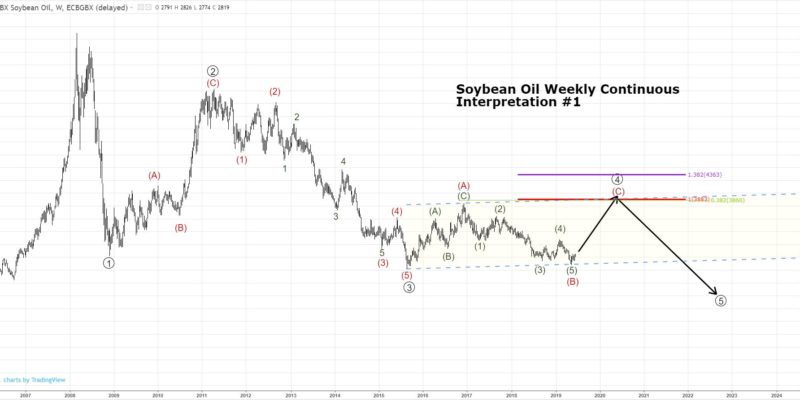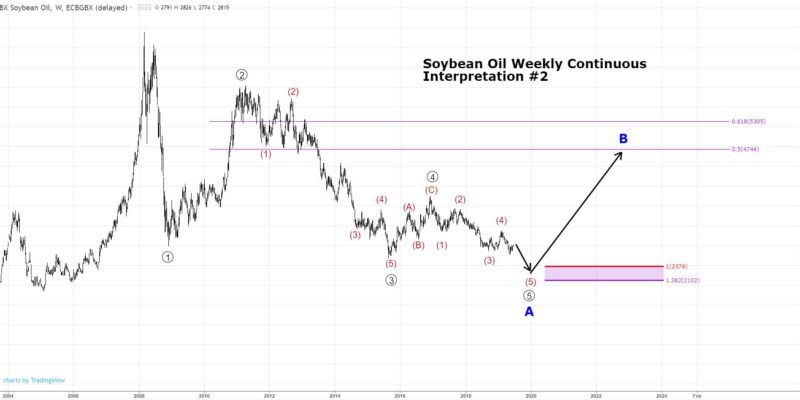Using Multiple Wave Counts to Gain Greater Confidence in Your Purchasing Decisions
The best argument from the naysayers of Elliott Wave theory as a market descriptor is the following statement: “The problem with using Elliott Wave is that you could have 3 separate analysts look at the same chart and they will come up with at least 3 different interpretations.” Certainly applying the Wave Principle can be more of an art than a science. However, this ambiguity can be a strength of the Wave Principle as opposed to a weakness. For example, if you have multiple potential outcomes using Elliott Wave analysis, but the different outcomes all suggest the same price action in the near-term, we can gain confidence that the short-term path is very probable.
Let’s apply this idea to the current soybean oil market. Below are 3 valid interpretations, each calling for a different path for price. The interpretations are labeled in order of their current respective probabilities of being correct. In other words, given our current information, Interpretation #1 is most probable, Interpretation #3 is least probable.
The case for interpretation #1: Target 38.60¢-42.60¢ over the course of the next 12-15 months

- Still need a wave (C) in wave 4.
- This would balance with the time it took wave 2 to play out.
- We could retrace 38% of wave 3 and wave (C) could equal wave (A).
- This entire move would stay within parallel lines.
The case for interpretation #2: Make new lows this year to the 25¢-24¢ area, then put in a significant bottom that will last years and prices will have an initial target of 47.44¢

- Need some further downside price action to complete wave (5) of 5
- This could complete a long-term Fibonacci target.
- This balances the wave structure
The case for interpretation #3: The long-term bottom is in! Prices will experience a multi-year rally that will target 48.58¢-53.90¢ over the course of the next 5 years.

- The minimum requirements for a completed Cycle Wave have been met with all subdivisions countable.
- Although we’d expect a new low, waves can become truncated if there is underlying buying/selling pressure that will become apparent later (after prices move).
Lets analyze what the wave interpretations are telling us in the aggregate.
What are the similarities of the 3 different wave interpretations?
They all call for prices to be significantly higher 12 months from now.
What is a difference between the 3 separate wave interpretations?
One interpretation suggests we see new lows towards 25.00¢. The other two suggest that the a tradeable bottom is complete and we will see prices reach atleast 38¢ in the coming year.
Given that the most probable interpretation has higher prices immediately AND that 2 of the 3 interpretations suggest higher prices immediately, it is safe to say the outcome of higher prices immediately has a greater probability of occurring than a new market low.
Risk-Reward Analysis
Interpretation #2 calls for lower prices in the immediate before much higher prices 12 months from now. What do we stand to benefit by waiting and trying to bottom-pick? The wave count suggests 3-4¢ as a reward. Let’s compare that to our risk of waiting and either interpretations #1 or #3 being correct. Both #1 and #3 call for initial targets of 38¢ and potential for much higher prices. That is significantly higher than current prices and certainly higher that you paid for your oils the last couple of years. This risk-reward suggests becoming aggressive with your long-term edible oil purchasing.